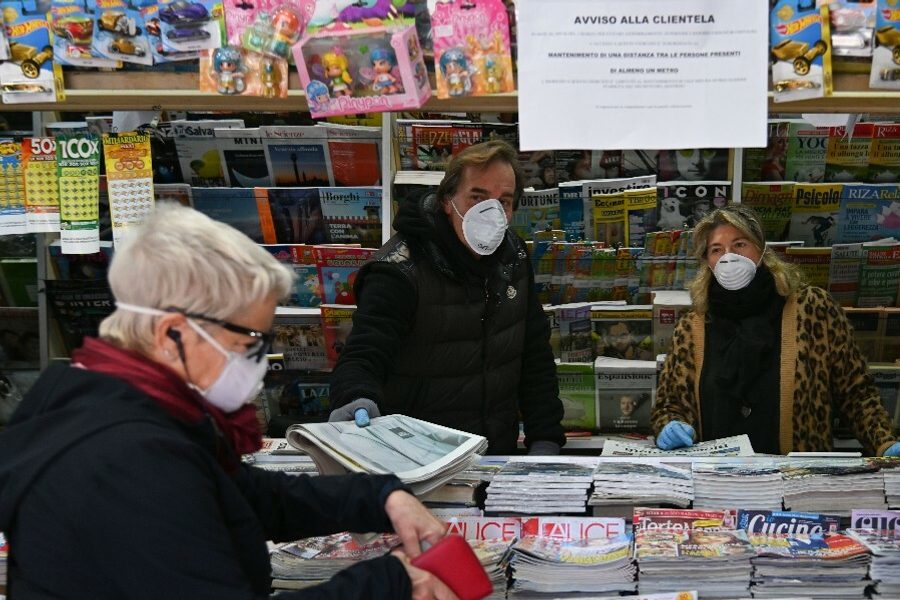In the Time of Coronavirus, the Decimation of Local News Outlets Could Have Lethal Consequences
Camille Baker

So many human failures have brought us to this point, in March 2020, when 803,650 people worldwide have tested positive for COVID-19, 39,033 people have died (though these figure will be old the moment this article publishes), and the rest of us are left wondering whether we are about to watch our loved ones die or end up on ventilators ourselves, drowning in our own lungs.
Some of the failures have been recent, public and obvious. President Donald Trump’s failure to speedily invoke the Defense Production Act to increase the manufacture of essential medical supplies. Republicans’ insistence on pushing forward with a stimulus bill that bails out corporations and, in some cases, does nothing for vulnerable people. Prison and jail officials’ refusal to release incarcerated people in time to prevent a devastating spread of the illness in prisons. The Chinese government’s suppression of information about the coronavirus in its early days, when its initial spread could have been stopped.
Other failures, less obvious, have been building for years. Take, for example, the fact that the battle against the coronavirus in many parts of the U.S. has partly been one of messaging. Officials have struggled to convince people to stay home to stem the virus’ spread.
At a briefing on March 22, New York Governor Andrew Cuomo’s voice strained as he admonished New Yorkers for being too numerous and close together in public over the weekend.
“I don’t know what I’m saying that people don’t get,” he said. “I’m normally accused of being overly blunt and direct. And I take that. It’s true. I don’t know what they’re not understanding. This is not life as usual. None of this is life as usual. … It has to stop now. This is not a joke. And I am not kidding.”
To understand why the pleas of experts and officials seem not to have gotten through to many people, we should recall that the virus has arrived in this country at a time when the field of journalism has been significantly eroded. There are many forces involved here, but news organizations are one of the most powerful tools we have for understanding and acting on the virus.
Consider that in Italy, France and Spain, where the governments have imposed extraordinary restrictions and closures to try to slow the spread of the virus, newsstands have been allowed to stay open, alongside grocery stores and pharmacies, because access to news and information was deemed essential. But in many parts of the U.S., even in ordinary times, you couldn’t go out and buy a local newspaper if you wanted to.
In recent decades, local news organizations, which investigate things national outlets don’t, have been decimated. Part of the problem is corporate media consolidation: As of 2018, just 25 companies owned two-thirds of the country’s daily newspapers, according to a report from PEN America. These corporations, driven by a profit motive, produce content that is increasingly homogenous, de-prioritize local reporting, and make decisions to cut staff or close papers altogether from distant big-city boardrooms. Since 2004, over 1,800 newspapers in the U.S. have closed. Over 500 of those were in rural areas.
The remaining media organizations are clustered on the coasts, in New York, Washington, D.C. and Los Angeles. The content they produce is biased toward urban, white, wealthy, male, English-speaking audiences. The effect of all this is that many rural areas and many of the most vulnerable people in the United States do not have access to a representative media.
In the context of the coronavirus, this dearth of local media has probably already killed people who did not receive or act on information about the virus before it was too late.
As local news organizations across the country have collapsed and been subsumed, in some cases, into right-leaning media conglomerates, some of these biases may have intensified. This, too, has had effects on the coronavirus’ spread. As cases began to climb across the country, conservative media downplayed the threat. And this rippled out along political lines: According to a poll from early March, around four in 10 Democrats said they thought the coronavirus posed an imminent threat, compared to about two in 10 Republicans.
Like many journalists, I now live in New York, though I grew up in a small town in Rhode Island. Communicating with friends at home as the virus began to spread across the U.S., I witnessed firsthand how many felt distrustful of media reports from the big cities that warned of the epidemic’s effects hundreds of miles away. They also didn’t know where to get accurate news. Were the reports, many asked, of catastrophes in Italy and New York and Seattle to be believed? Where was I getting my news? How could they reconcile the message of impending doom with the reality outside their houses, which remained basically unchanged? What should they believe―the newspapers, or their own eyes?
“I had heard NYC is on the verge of Italy measures but you know the news,” my friend in suburban Rhode Island wrote to me Thursday. By Sunday, the virus had caught up to her; she thought she might have been exposed.
If local news outlets were still robust near where she lives, perhaps this disconnect would not have happened―and if people across the country could access coverage that reflected their local experience, so many might not dismiss warnings about the virus as alarmist. A robust local news organization could also tailor its coverage of the pandemic to the needs of people in its area, spreading information about the presence of infections locally, where to seek healthcare, and nearby resources for confronting work closures and impending rent payments.
The additional bad news is that the virus may totally kill many more local newspapers and alt weeklies, even as online news traffic at major news publishers has shot up in the last weeks. There have been layoffs at the Euclid Media Group, which owns the Detroit Metro Times and St. Louis’ Riverfront Times; the Tampa Bay Times; News & Review newspapers in Sacramento, Chico and Reno, California; the Portland Mercury; Monterey County Weekly and Isthmus in Madison, Wisconsin, according to CNN. (Joshua Benton at NiemanLab has counted up more of the alt-weekly closures.) The Advocate, a daily newspaper in Louisiana, announced recently that it would furlough a tenth of its workforce. C & G Newspapers in Michigan announced it would pause printing. The Rutland Herald and the Times Argus in Vermont are laying off staffers and reducing printing. Florida’s Tampa Bay Times has laid off 11 staffers. Rhode Island’s Providence Business News has suspended its print edition. Even the Seattle Times, which covered the country’s first coronavirus death in Washington state, is suffering as its advertising business has taken a severe hit.
The coronavirus crisis is laying bare not only vulnerabilities in the supply chain and the production system but in American information systems―vulnerabilities caused in part by the collapse of local news.
This crisis offers a warning that we should not ignore. We must find a way to rebuild and reinvigorate our local news systems for the larger crises yet to come.

I hope you found this article important. Before you leave, I want to ask you to consider supporting our work with a donation. In These Times needs readers like you to help sustain our mission. We don’t depend on—or want—corporate advertising or deep-pocketed billionaires to fund our journalism. We’re supported by you, the reader, so we can focus on covering the issues that matter most to the progressive movement without fear or compromise.
Our work isn’t hidden behind a paywall because of people like you who support our journalism. We want to keep it that way. If you value the work we do and the movements we cover, please consider donating to In These Times.



